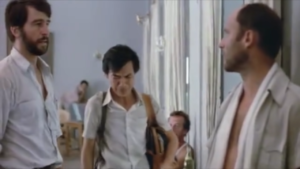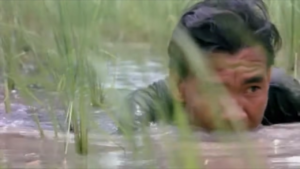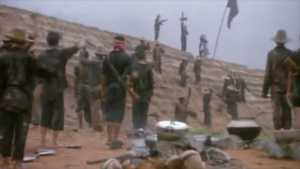Rating: 4.75 out of 5




![]()
I have written many times about my dad fighting in Vietnam and some of the horrors that he has seen. As that war drew to an end, many didn’t know that a civil war was going on right next door in Cambodia between the Cambodian national army and the communist Khmer Rouge group. They ruled Cambodia between 1975 and 1979. The Khmer Rouge regime was highly autocratic, totalitarian, and repressive, with many deaths happening. Not deaths but a genocide. The Khmer Rouge regime murdered hundreds of thousands of their perceived political opponents. During the genocide, it is estimated that between 1.5 to 2 million people died, equivalent to 25% of Cambodia’s population. The regime was removed from power in 1979 when Vietnam invaded Cambodia and destroyed most of the Khmer Rouge’s forces.

The Killing Fields was directed by Roland Joffé and is a biographical film about two journalists’ experiences during the Khmer Rouge regime. Set in 1973, towards the end of the Vietnam War and the beginning of the Cambodian civil war, New York Times reporter Sydney Schanberg (Waterston) is sent to Cambodia to meet Dith Pran (Ngor) as his guide and interpreter. Over the next few years, the two become good friends as they take pictures of what is going on. Things become serious when the US forces pull out. Schanberg manages to get exit visas for Pran’s family. Pran’s family manages to escape, but Pran stays behind. The Khmer Rouge roll in with great cheers from the city and take complete control. Schanberg and other western journalists are captured but are soon evacuated. Pran is left behind to work in labor camps. Schanberg, along with his colleagues, works to save Pran from the terrors of the Khmer Rouge and out of Cambodia.
When you get a movie called the Killing Fields, you know it will probably be intense. Holy shit, was this film intense. The plot has two stories in one. The film’s first half is dedicated to Schanberg and his quest to write about what was happening in Cambodia with Cambodian journalist and interpreter Dith Pran. When Schanberg arrives, it seems like any other day. He takes a cab to his hotel and meets up with photographer Al Rockoff. They go to some café and talk while ordering breakfast. A typical day and then all hell breaks loose. BOOM! A big ass bomb goes off and kills many. Bodies lying on the ground, and it was a warzone. Schanberg and Rockoff take photos until Pran comes and lets Schanberg know that an American B-52 has allegedly bombed Neak Leung. They rush off to confirm, and the place looks like absolute carnage. It is straight-up sad as people’s lives and families are destroyed. As they take pictures, a jeep rolls up and arrests them when they try to take photos of an execution.

The film and story get crazier when the army is attacked. There was an intense battle scene, and then we see the Americans flee the embassy. When the journalist goes to the hospital, it will make you sick. The scene with the little girl will make your stomach turn. When the journalist try to leave, they are captured. A little kid with a gun holds them up. They are taken to some prison, and shit gets real. There is a line of prisoners, and the music is intense. There is a soldier with his gun pointed at several prisoners with an apple on a bayonet. One of the prisoners tries to bite the apple and gets shot in the head. Once again, shit got real.
When the city is evacuated, Schanberg, Pran, and the rest of the journalist help people flee as the army rolls in. It is one of the most harrowing scenes to watch, but the danger is about to get real for Pran as his family makes it out, but he decides to stay behind. The Khmer Rouge orders all Cambodian citizens to be handed over. The group knows that Pran will be imprisoned or killed, and they devise a plan to forge a British passport for Pran. The passport looks good, but when Pran’s picture disappears, they know they have failed. Pran is soon turned over to the Khmer Rouge, and the journalist leave the country. During Pran’s encampment, Schanberg tries to bring his homeboy home. He makes calls to get information and tries to find out if he is still alive. He writes letters to several charities and maintains close contact with Pran’s family in San Francisco. As the years passed, Schanberg was awarded a Pulitzer Prize for his coverage of the Cambodian conflict. He gives half the recognition to Pran, but Rockoff sees the bullshit and harshly accuses him of not doing enough to locate Pran and for using his friend to win the award.
The second half of the film is about Pran’s survival. Homeboy really went through hell and back and hell again to survive in the totalitarian regime of the Khmer Rouge. Pran is forced to work in a labor camp under the Khmer Rouge’s “Year Zero” policy. During this, Pran is also forced to attend propagandist classes, where he is re-educated. Intellectuals are killed, so Pran acts with simple-mindedness. In one scene, with the need for nutrients, he goes to the cow stable and makes small cuts on the cows to drink their blood. As he tries to leave, he is caught. He is about to be executed, but they let him go and give him a stern warning. He tries to escape again and makes it a nice distance until he stumbles into the regime’s killing fields. The fields are mind-blown as skeleton bones litter the water and land. It is an unimaginable scene. Pran is recaptured again. Pran is moved to a different prison compound, whose leader, Phat, puts him in charge of mostly attending to his young son. Pran continues to act like an uneducated person, but Phat makes several attempts to catch him in his lie. Pran manages to keep calm when Phat asks Pran to take ward of his son if he is killed. Through a series of events, Pran manages to make it to freedom.

This film has some of the best cinematography I have seen. It showed the destruction of war and how it influences the lives of those around the affected area. One scene stood out the most to me, and that was the fleeing scene. Watching thousands of people run down the railroad track with all their belongings is heartbreaking. You could sense the fear.
What added most to all the scenes was the freaking music. Good lord was the music intense, harrowing and added an emotional element to all the scenes. The music was some of the best I heard as it truly displayed the emotions of the characters and everyone around.
The acting was good in this film. Only one actor stood out above the rest. First, Sam Waterston as Sydney Schanberg was the star of the film. He was okay in this role. Sometimes he was a hard ass, and sometimes he showed sympathy. I really didn’t feel anything for him because he got out.
Haing S. Ngor as Dith Pran was spectacular in his role. I read that he was a refugee and survivor of the Cambodian genocide. This amazing man survived three years in Cambodian prison camps before escaping. He was convinced to conceal his intellect and medical abilities and even not wear glasses because his life depended on it. Even though he played Pran, you felt Ngor brought his real-life experience during the ordeal into this film. That is why he is so convincing in this role. I have to applaud his performance and courage for the memories that he must’ve gone through while making this film.
The Killing Fields is one of those films that will surprise you. Based on the title, I had a feeling that it would be intense, but I wasn’t expecting what was to come. The film is strong, with a historical story, great acting, fantastic cinematography, and music.